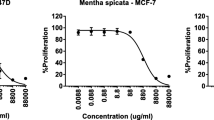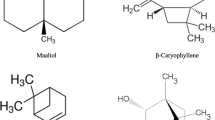Abstract
Background and aim
Foeniculum vulgare (F. vulgare) Mill, commonly known as fennel, belongs to the Umbelliferae (Apiaceae) family, biennial or perennial herbs disseminated in Mediterranean region and central Europe. This herbal medicine (HM) is considered as a traditional HM, and its parts have been studied.
Methods
In this survey, essential oils from seeds collected from three various regions (Kerman, Golestan, and East Azerbaijan Provinces) of Iran were prepared with hydro-distillation and their components were analyzed with gas chromatography (GC) and chromatography time-of-flight mass spectrometry (GC/MS). Antimicrobial and cytotoxic activities of the essential oils were examined with disk-diffusion method on Muller–Hinton agar and Subaru-dextrose Agar, respectively. Additionally, the MTT assay was assessed on breast cancer cell line (MCF-7). The expression of apoptosis-related genes, Bax and Bcl2, was determined using quantitative real-time PCR (RT-qPCR).
Results
The major fractions of essential oils identified by GC and GC/MS included trans-anethole (78.47%, 49.64%, 78.68%), fenchone (10.5%, 8.4%, and 10.2%), and limonene (5.9%, 6.70%, and 5.6%), respectively. Fennel oil collected from three various places exerted inhibitory effects on the bacterial growth and higher cytotoxic effects on MCF-7 cancer cell line. In addition, the essential oil increased the expression of Bax, but decreased Bcl2 gene expression significantly (P < 0.001).
Conclusion
According to our findings, F. vulgare essential oil can be considered as a promising agent opening venues for novel antimicrobial and anticancer therapies. Owing to side effects and expensiveness of chemotherapy approaches, HM is a new remarkable insight for future therapies.


Similar content being viewed by others
References
Akhbari M, Kord R, Jafari Nodooshan S, Hamedi S. Analysis and evaluation of the antimicrobial and anticancer activities of the essential oil isolated from Foeniculum vulgare from Hamedan, Iran. Nat Prod Res. 2018:1–4.
Alizadeh AM, Sadeghizadeh M, Najafi F, Ardestani SK, Erfani-Moghadam V, Khaniki M, et al. Encapsulation of curcumin in diblock copolymer micelles for cancer therapy. Biomed Res Int. 2015;2015:824746.
Al-Mariri A, Safi M. In vitro antibacterial activity of several plant extracts and oils against some gram-negative bacteria. Iran J Med Sci. 2014;39:36.
Al-Marzoqi AH, Hameed IH, Idan SA. Analysis of bioactive chemical components of two medicinal plants (Coriandrum sativum and Melia azedarach) leaves using gas chromatography-mass spectrometry (GC-MS). Afr J Biotechnol. 2015;14:2812–30.
Alzoreky N, Nakahara K. Antibacterial activity of extracts from some edible plants commonly consumed in Asia. Int J Food Microbiol. 2003;80:223–30.
Anand P, Kunnumakara AB, Sundaram C, Harikumar KB, Tharakan ST, Lai OS, et al. Cancer is a preventable disease that requires major lifestyle changes. Pharm Res. 2008;25:2097–116.
Chen CH. Anethole suppressed cell survival and induced apoptosis in human breast cancer cells independent of estrogen receptor status. Phytomedicine. 2012;19:763–7.
Diao W-R, Hu Q-P, Zhang H, Xu J-G. Chemical composition, antibacterial activity and mechanism of action of essential oil from seeds of fennel (Foeniculum vulgare Mill.). Food Control. 2014;35:109–16.
El-Soud N, El-Laithy N, El-Saeed G, Wahby M, Khalil M, Morsy F, et al. Antidiabetic activities of Foeniculum vulgare mill. Essential oil in streptozotocin-induced diabetic rats. Macedonian J Med Sci. 2011;4:139–46.
Farhangi B, Alizadeh AM, Khodayari H, Khodayari S, Dehghan MJ, Khori V, et al. Protective effects of dendrosomal curcumin on an animal metastatic breast tumor. Eur J Pharmacol. 2015;758:188–96.
Ghasemian A, Mobarez AM, Peerayeh SN, Abadi ATB, Khodaparast S, Nojoomi F. Report of plasmid-mediated colistin resistance in Klebsiella oxytoca from Iran. Rev Med Microbiol. 2018a;29:59–63.
Ghasemian A, Shafiei M, Hasanvand F, Mostafavi SKS. Carbapenem and colistin resistance in Enterobacteriaceae: worldwide spread and future perspectives. Rev Med Microbiol. 2018b;29:173–6.
Golestannejad Z, Gavanji S, Mohammadi E, Motamedi A, Bahrani M, Rezaei F, et al. Comparison of antibacterial activity of essential oils of Foeniculum vulgare Mill, Mentha arvensis and Mentha piperita against Streptococcus mutans. Advanced Herbal Medicine. 2017;1.
Kaur GJ, Arora DS. Antibacterial and phytochemical screening of Anethum graveolens, Foeniculum vulgare and Trachyspermum ammi. BMC Complement Altern Med. 2009;9:30.
Khavari-Daneshvar H, Mosavi M, Khodayari H, Rahimi E, Ranji P, Mohseni AH, et al. Modifications of mice gut microflora following oral consumption of Lactobacillus acidophilus and Bifidobacterium bifidum probiotics. Turk J Med Sci. 2017;47:689–94.
Khodayari S, Alizadeh A, Kouhpayeh S, Mohsenikia M, Karimi A, Khodayari H, et al. The acute and chronic toxicity effects of alpha-solanine in mice. J Babol Univ Med Sci. 2013;15:24–31.
Khosravi RA, Shokri H, Farahnejat Z, Chalangari R, Katalin M. Antimycotic efficacy of Iranian medicinal plants towards dermatophytes obtained from patients with dermatophytosis. Chin J Nat Med. 2013;11:43–8.
Klevens RM, Edwards JR, Richards Jr CL, Horan TC, Gaynes RP, Pollock DA, et al. Estimating health care-associated infections and deaths in US hospitals, 2002. Public Health Rep. 2007;122:160–6.
Kooti W, Moradi M-T, Ali-Akbari S, Sharafi-Ahvazi N, Asadi-Samani M, Ashtary-Larky D. Therapeutic and pharmacological potential of Foeniculum vulgare Mill: a review. Journal of HerbMed Pharmacology. 2014;4.
Kubo I, Fujita KI, Nihei KI. Antimicrobial activity of anethole and related compounds from aniseed. J Sci Food Agric. 2008;88:242–7.
Levy SB, Marshall B. Antibacterial resistance worldwide: causes, challenges and responses. Nat Med. 2004;10:S122–9.
Magill SS, Edwards JR, Bamberg W, Beldavs ZG, Dumyati G, Kainer MA, et al. Multistate point-prevalence survey of health care–associated infections. N Engl J Med. 2014;370:1198–208.
Malini T, Vanithakumari G, Megala N, Anusya S, Devi K, Elango V. Effect of Foeniculum vulgare mill. Seed extract on the genital organs of male and female rats. Indian J Physiol Pharmacol. 1985;29:21–6.
Mohamad RH, El-Bastawesy AM, Abdel-Monem MG, Noor AM, Al-Mehdar HAR, Sharawy SM, et al. Antioxidant and anticarcinogenic effects of methanolic extract and volatile oil of fennel seeds (Foeniculum vulgare). J Med Food. 2011;14:986–1001.
Mohsenikia M, Alizadeh AM, Khodayari S, Khodayari H, Karimi A, Zamani M, et al. The protective and therapeutic effects of alpha-solanine on mice breast cancer. Eur J Pharmacol. 2013;718:1–9.
Muckensturm B, Foechterlen D, Reduron J-P, Danton P, Hildenbrand M. Phytochemical and chemotaxonomic studies of Foeniculum vulgare. Biochem Syst Ecol. 1997;25:353–8.
Norrby SR, Nord CE, Finch R. Lack of development of new antimicrobial drugs: a potential serious threat to public health. Lancet Infect Dis. 2005;5:115–9.
Palumbo F, Vannozzi A, Vitulo N, Lucchin M, Barcaccia G. The leaf transcriptome of fennel (Foeniculum vulgare Mill.) enables characterization of the t-anethole pathway and the discovery of microsatellites and single-nucleotide variants. Sci Rep. 2018;8:10459.
Piccaglia R, Marotti M. Characterization of some Italian types of wild fennel (Foeniculum vulgare Mill.). J Agric Food Chem. 2001;49:239–44.
Redo M, Rios J, Villar A. A review of some antimicrobial compounds isolated from medicinal plants reported in the literature 1978–1988. Phytother Res. 1989;3:117–25.
Reynolds J. Essential oils and aromatic carminatives. Martindale, The Extra Pharmacopeia. 28th ed. London: Royal Pharmaceutical Society; 1982. 670
Shahat AA, Ibrahim AY, Hendawy SF, Omer EA, Hammouda FM, Abdel-Rahman FH, et al. Chemical composition, antimicrobial and antioxidant activities of essential oils from organically cultivated fennel cultivars. Molecules. 2011;16:1366–77.
Sharopov F, Valiev A, Satyal P, Gulmurodov I, Yusufi S, Setzer WN, et al. Cytotoxicity of the essential oil of fennel (Foeniculum vulgare) from Tajikistan. Foods. 2017;6:73.
Shellie RA, Marriott PJ. Comprehensive two-dimensional gas chromatography-mass spectrometry analysis of Pelargonium graveolens essential oil using rapid scanning quadrupole mass spectrometry. Analyst. 2003;128:879–83.
Singh B, Kale R. Chemomodulatory action of Foeniculum vulgare (fennel) on skin and forestomach papillomagenesis, enzymes associated with xenobiotic metabolism and antioxidant status in murine model system. Food Chem Toxicol. 2008;46:3842–50.
Singh G, Maurya S, De Lampasona M, Catalan C. Chemical constituents, antifungal and antioxidative potential of Foeniculum vulgare volatile oil and its acetone extract. Food Control. 2006;17:745–52.
Funding
This work was financially supported by the Islamic Azad University and Tehran University.
Author information
Authors and Affiliations
Contributions
MT conceived the ideas and collected data; AGH and SKM analyzed the data and led the writing.
Corresponding author
Ethics declarations
This study was ethically approved by Islamic Azad University, Roudehen, Iran.
Conflict of Interest
The authors declare that they have no conflict of interest.
Additional information
Publisher’s Note
Springer Nature remains neutral with regard to jurisdictional claims in published maps and institutional affiliations.
Rights and permissions
About this article
Cite this article
Ghasemian, A., Al-Marzoqi, AH., Mostafavi, S.K.S. et al. Chemical Composition and Antimicrobial and Cytotoxic Activities of Foeniculum vulgare Mill Essential Oils. J Gastrointest Canc 51, 260–266 (2020). https://doi.org/10.1007/s12029-019-00241-w
Published:
Issue Date:
DOI: https://doi.org/10.1007/s12029-019-00241-w




